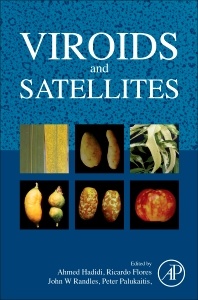Viroids and Satellites
Coordonnateurs : Hadidi Ahmed, Flores Ricardo, Randles John W, Palukaitis Peter

Viroids and Satellites describes plant diseases and their causal agents while also addressing the economic impact of these diseases. The book discusses various strategies for state-of-the-art methods for the detection and control of pathogens in their infected hosts and provides pivotal information from the discovery of viroids through the analysis of their molecular and biological properties, to viroid pathogenesis, host interactions, and RNA silencing pathways.
Students, researchers and regulators will find this to be a comprehensive resource on the topics presented.
VIROIDS
Part I Viroids: Economic Significance 1. Economic significance of viroids in vegetable and field crops 2. Economic significance of fruit tree and grapevine viroids 3. Economic significance of viroids in ornamental crops 4. Economic significance of palm tree viroids
Part II Viroid Characteristics 5. Viroid biology 6. Viroid structure 7. Viroid replication 8. Viroid movement 9. Viroid pathogenesis 10. Changes in the host proteome and transcriptome induced by viroid infection 11. Viroids and RNA silencing 12. Origin and evolution of viroids 13. Viroid taxonomy
Part III Viroid Diseases 14. Potato spindle tuber viroid 15. Other pospiviroids infecting solanaceous plants 16. Citrus exocortis viroid 17. Chrysanthemum stunt viroid 18. Iresine viroid 1 and a potential new pospiviroid from portulaca 19. Hop stunt viroid 20. Dahlia latent viroid 21. Apple scar skin viroid 22. Other apscaviroids infecting pome fruit trees 23. Apscaviroids infecting citrus trees 24. Apscaviroids infecting grapevine 25. Coconut cadang-cadang viroid and coconut tinangaja viroid 26. Other cocadviroids 27. Coleus blumei viroids 28. Avocado sunblotch viroid 29. Peach latent mosaic viroid in infected peach 30. Peach latent mosaic viroid in temperate fruit trees other than peach 31. Chrysanthemum chlorotic mottle viroid 32. Eggplant latent viroid
Part IV Detection and Identification Methods 33. Viroid detection and identification by bioassay 34. Gel electrophoresis 35. Molecular hybridization techniques for detecting and studying viroids 36. Viroid amplification methods: RT-PCR, Real- Time RT-PCR and RT-LAMP 37. Detection and identification of viroids by microarrays 38. Application of next-generation sequencing technologies to viroids
Part V Control Measures for Viroids and Viroid Diseases 39. Quarantine and certification for viroids and viroid diseases 40. Viroid elimination by thermotherapy, cold therapy, tissue culture, in vitro micrografting or cryotherapy 41. Decontamination measures to prevent mechanical transmission of viroids 42. Strategies to introduce resistance to viroids
Part VI Geographical Distribution of Viroids and Viroid Diseases 43. Geographical distribution of viroids in the Americas 44. Geographical distribution of viroids in Europe 45. Geographical distribution of viroids in Africa and the Middle East 46. Geographical distribution of viroids in Oceania 47. Geographical distribution of viroids in South, Southeast and East Asia
Part VII Special Topics 48. Seed, pollen and insect transmission of viroids 49. Genome editing by CRISPR-based technology: potential applications for viroids
SATELLITES
Part VIII Introduction 50. Satellite viruses and satellite nucleic acids
Part IX Impact of Satellites 51. Economic significance of satellites
Part X Satellite Characteristics 52. Biology of satellites 53. Replication of satellites 54. Satellite RNAs: their involvement in pathogenesis and RNA silencing 55. Development and application of satellite-based vectors 56. Origin and evolution of satellites 57. Satellite taxonomy
Part XI Types Satellites: A. Satellite Viruses 58. Biology and pathogenesis of satellite viruses
B. Satellite Nucleic Acids 59. Large satellite RNAs 60. Small linear satellite RNAs 61. Small circular satellite RNAs 62. Betasatellites of begomoviruses
Part XII Application to Control of Viruses 63. Satellites as viral biocontrol agents
Researchers in basic and applied plant virology, plant pathology, microbiology, genetics and molecular biology, biological control, ecology, and related aspects of plant science; upper-level graduate students of plant virology
Ricardo Flores is a world-renowned expert on the topic of viroids and has been on the frontier of virology research.
John W. Randles is an internationally acclaimed plant virologist and his key research interest is on the cause and characterization of viruses and viroids. He is the course coordinator for classical diagnostic methods as well as molecular and biochemical methods in plant health at the University of Adelaide.
Peter Palukaitis is an internationally acclaimed researcher in the field of plant pathology. His key research area is the molecular mechanisms of plant-virus interactions, with particular reference to pathogenic and resistance responses.
- Provides coverage of the basic biological properties of disease, along with applied knowledge
- Features economic impacts, transmission, geographical distribution, epidemiology, detection, and control within each chapter
- Organizes viroid diseases by viroid taxonomy and viroid species
Date de parution : 08-2017
Ouvrage de 716 p.
15x22.8 cm
Épuisé
Thèmes de Viroids and Satellites :
Mots-clés :
2D PAGE; Africa; African oil palm; Agriculture; Alpha acids; Alphasatellites; Ameliorative satellite RNA; Amplification techniques; Apple dimple fruit viroid; Apple fruit crinkle viroid; Apple scar skin viroid; Apscaviroids; Arabis mosaic virus large satellite RNA (satArMV); Asia; Australia; Avocado sunblotch disease; Avocado sunblotch viroid; Avsunviroid; Avsunviroidae; Bamboo mosaic virus satellite RNA (satBaMV); Begomovirus; Begomoviruses; Betasatellite; Betasatellites; Biological control; Biological indexing; Blackcurrant reversion virus satellite RNA (satBRV); Brewing; CBLVd; CCCVd; CCCVd variants; CDVd; CRISPR/Cas; CTiVd; CVd-V; CVd-VI; Cadang-cadang; Cadang-cadang history; Capsicum; Caribbean; Catalytic RNA; Catalytic RNAs; Central America; Certification protocols; Chardonnay; Chemotherapy; Chicory yellow mottle virus satellite RNA (satChYMV); Chrysanthemum stunt viroid; Circular RNA; Circular RNAs; Citrus; Citrus cachexia viroid; Citrus rootstocks; Citrus viroid II; Citrus viroids; Classification; Cocos nucifera; Cold therapy; Coleus blumei; Coleus blumei viroid 1 (CbVd-1); Coleviroid; Combining molecular and biological assay; Control; Cryotherapy; Cucumber mosaic virus; Cucumber pale fruit viroid; Cytopathic effects; Cytopathology; DNA ligase; DNA methylation; DNA-β; Dahlia latent viroid; Dapple apple; Decontamination; Detection; Diagnostics; Dicer-like (DCL) endonucleases; Discovery; Disease; Disease symptoms; Disinfection; Distribution; Dot-blot hybridization; DsRNA; Dwarfing; Economic losses; Economic significance; Eggplant; Elaeis guineensis; Emerging; End point RT-PCR; Epidemiology; Europe; Experimental evolution; Factors affecting bioassay; Family; Field crops; Fruit tree viroids; Gel hybridization; Geminivirus



